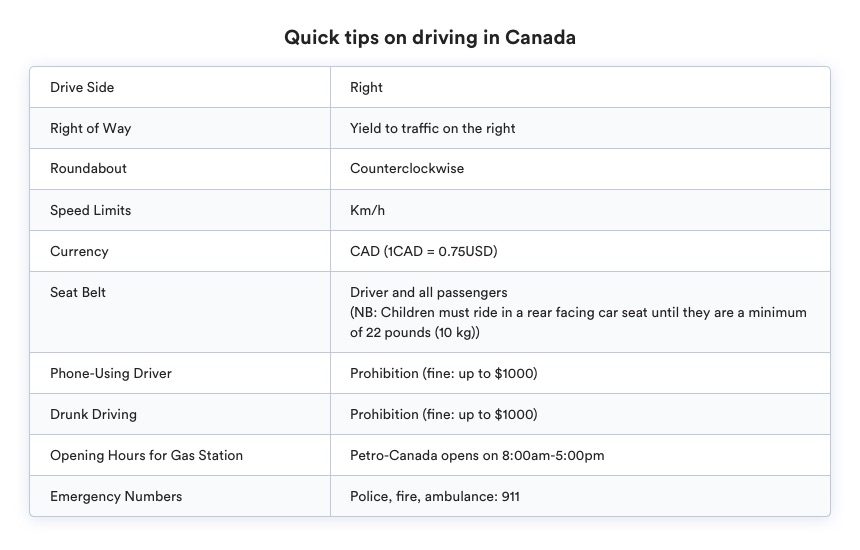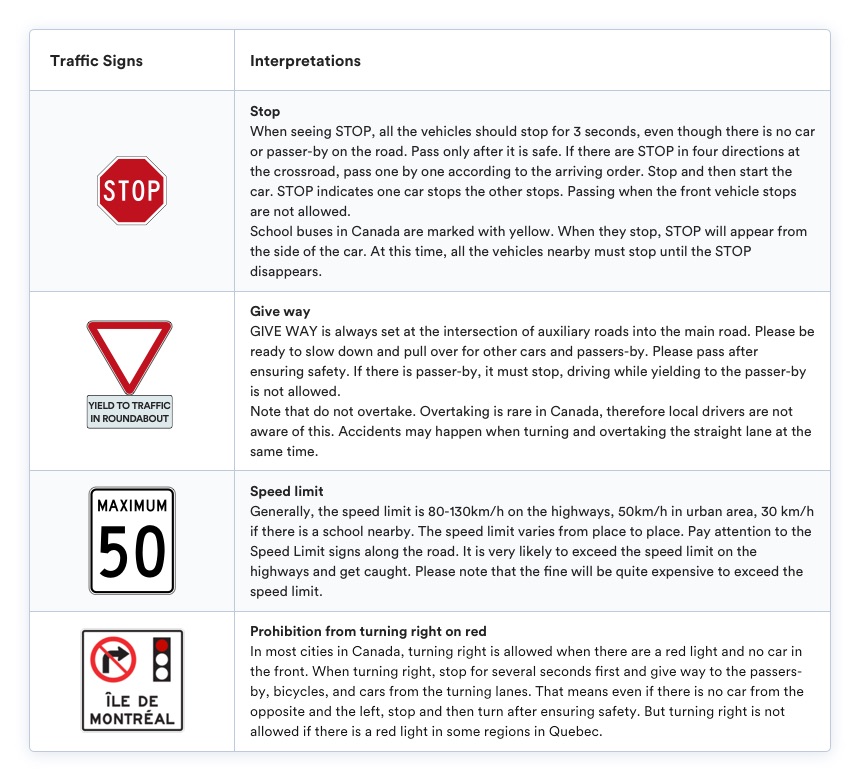No matter the national parks with spectacular scenery or the beautiful streets with maples, Canada attracts numerous self-drivers for visiting. It is not difficult to drive in Canada due to the extensive road network, good road conditions, and strict but reasonable traffic rules. The signs are clear and as long as you are familiar with this and observe it, it is a great option to have a self-drive trip here. So now take your bags and get ready to enjoy an unforgettable self-driving trip.
1. Driving Rules and Tips
- Speed Limit
Motorways – 100 km/h
Built-up areas – 50 km/h
Rural areas – 80 km/h
- Traffic and Road Signs
For more information about Canada road signs, here is an infographic from QEEQ.COM.
2. Road Condition and Toll Roads
- Road Condition
Road condition in Canada is good with wide roads and enough and clear signs. Generally, there are guardrails on the side of the road. Be careful when turning and wait at slow speed.
Be cautious when driving in the mountainous area in winter. Snow tires and anti-skid chains are necessary sometimes.
- Toll Roads
On the highways, Car Pool Only with rhombus on the road is exclusive for those vehicles with 2 or more passengers. Vehicles with one person are not allowed, otherwise, it will be fined. The motor is allowed on the highways in Canada, usually with 100 km/h speed. Therefore be careful about the motor. Driving on the highways is usually free of charge, except one in northern Toronto — Highway 407. When planning the trip, avoid Highway 407, choose non-toll highways such as Highway 401,403 or QEW (Queen Elizabeth Way).
How to pay?
No toll station is set on highway 407, and there is no need to park here. Combine the image recognition system and the electronic transceiver to charge the fee.
If the vehicle is equipped with the electronic sensor when the vehicles pass the highways and they will be charged automatically. If not, drivers need to log in this website to fill in the info to pay the fee within a few days after passing highway407.
3. Gas
In Canada, gas stations, such as Esso, Shell, Chevron, PetroCanada, Husky, Mohawk, and so on, are common. The types of gasoline in Canada are divided into 87 (Regular, Unleaded), 89 (Plus, Mid-Grade), 91 (Supreme, Premier) and 93 (V-Power). The larger the number, the higher the quality of petrol and the more expensive the price is. Most cars are filled with No.87, and the diesel vehicle will be marked with Diesel.
When refueling in Canada, you can follow the instructions on the car or the fuel tank cap and fill the tank with the designated fuel. If you are not sure which fuel to choose, consult the branch staff when picking up the car.
Expert tips: Be careful not to fill the tank with the wrong fuel. If you refuel with the wrong fuel, please contact the branch as soon as possible to clean up the fuel tank and the fuel system and conduct an overall inspection of the engine. Don’t start the car in haste to avoid car damage.
How to pay?
Gas stations in Canada are self-service refuel, half self-service refuel and refuel by the staff.
Canada’s gas stations are mostly self-service. You can pay by credit card and cash.
- Refueling with credit card
Step1: Insert the credit card
Step2: Enter the information as required
Step3: Remove the credit card
Step4: Select the petrol type
Step5: Pick up the fuel pump nozzle and start filling up
- Refueling with cash
Step1: Remember the nozzle number
Step2: Pay in cash at the counter
Step3: Choose the petrol type at the pump
Step4: Pick up the fuel pump nozzle and start filling up
Step5: Get your change back at the counter
Expert tips:
1. Gas stations are mainly set in the cities, towns. If you are to some remote area, please fill up the tank when there is a gas station.
2. Gas price varies from place to place. There is no standard price. Generally, prices in cities will be cheaper than that in other areas. It is recommended to compare the price of different places during the trip.
4. Parking
- Public parking
There are free public parking lots around the shopping center and supermarkets but usually, have time limits. Some shopping malls only allow people who shop here to park their cars; otherwise, they will be fined.
There are charging parking lots in scenic spots and popular area. The parking space will be separated by white lines to differentiate the bus and the car. Park according to the marks. Unless special circumstances, it must be parked with the front car inside.
- On-street parking
When parking at the roadside, pay attention to the info on the STOP sign which indicates parking area and time limits. If you park over time, you are likely to be fined.
How to pay?
There are 4 ways to pay the parking fee: pay at the parking meter, pay by cars, pay by the staff and pay on the phone.
- Pay at the parking meter
Follow the instructions to put in the coins. There is always a time limit with no more than 3hrs. Continuing to pay beyond the time limit is not allowed.
- Pay by card
Pay by card within the limited time. Note that put the receipt on the windshield.
- Pay by the staff
There are staff to help pay the fee.
- Pay on the phone
Call the designated number to pay the fee. Provide info according to the instructions.
Expert tips:
1. It is recommended to plan the parking area in advance, which will save time in finding the parking place, and also reduce the parking fee.
2. In Toronto and Vancouver, there is much free parking area on the street. Search on this website, enter the address, scenic spots or zip code. Generally, it allows to park 1-3 hours for free (only applicable to Monday to Friday 9 am-8 pm).
3. Do not leave your luggage in the car if no people take care of it after parking.
5. Tickets
The rental company may pay the fine for you if there is unknown fine when coming back. But usually it is more expensive than the fee for breaking rules, which is included administration fee from the rental company.
How to pay?
Most of the car rental companies provide service of paying for the fine for customers. When the car rental company receives the info of violation, it will automatically charge the fine and administration fee directly from the credit card provided at the pick- up.
If the car rental company doesn’t provide this kind of service, the user should pay by himself. When receiving the ticket, pay the fee on the designated website with the reference number.
If there is no violation record during the rental, the deposit will be unfrozen and returned to the credit card of the main driver within a month.
Expert tips:
It’s better to know whether there is toll road or toll bridge and any possible illegal behaviors in advance. It would be better to pay the fine as soon as possible in case of high overdue fine.
Visit QEEQ.COM.com now.
QEEQ.COM guarantees the most competitive car rental deals for your travel and the secret is our Price Drop Protector program! We can automatically track your rental rates and RE-BOOK you if prices drop! See how our customers love this feature here.




